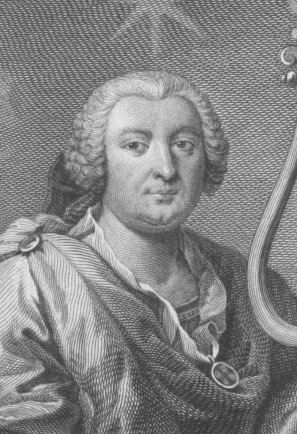Carlos Seixas facts for kids
Quick facts for kids
Carlos Seixas
|
|
|---|---|
 |
|
| Born | 11 June 1704 |
| Died | 25 August 1742 (aged 38) |
| Nationality | Portuguese |
| Occupation | Composer |
José António Carlos de Seixas (born June 11, 1704 – died August 25, 1742) was a very important Portuguese composer from the 1700s. He was an amazing player of both the organ and the harpsichord. When he was only 14, Carlos Seixas took over from his father as the main organ player at the Coimbra Cathedral.
In 1720, he moved to Lisbon, the capital city. There, he became the organist for the royal family's chapel, which was one of the most important music jobs in Portugal. This special role even earned him a knighthood! Much of Seixas's music shows a mix of older, more formal styles from the 1600s and newer, lighter styles from the 1700s.
Contents
Life of Carlos Seixas
Carlos Seixas was born in Coimbra, Portugal. His father, Francisco Vaz, was also a musician and played the organ at the cathedral. Carlos grew up surrounded by music. The nearby Santa Cruz monastery also helped him learn about music.
In 1718, just a few days before his father passed away, Carlos took over his father's job as the cathedral organist. Two years later, in 1720, he moved to Lisbon. He started his new job at the court of John V of Portugal, playing the organ and harpsichord for the king.
A Favorite Music Teacher
Carlos Seixas was known for his elegant and skillful playing. Many important families wanted him to teach their children. For example, he taught the wife and daughters of the Viscount of Barbacena how to play the harpsichord. In return, they supported his artistic work.
In Lisbon, Seixas met Domenico Scarlatti, a famous Italian composer. Scarlatti worked in Portugal from 1719 to 1728 as the director of the royal chapel. There's a story that the king's brother, Dom António, wanted Scarlatti to give Seixas harpsichord lessons. But Scarlatti quickly saw how talented Seixas was and said, "You can give me lessons!"
Family and Knighthood
In 1731, when he was 28, Carlos Seixas married D. Maria Joana Tomásia da Silva. They had two sons and three daughters. In 1738, the king made him a knight, welcoming him into the Order of Christ.
Sadly, four years later, in 1742, Carlos Seixas died from a fever. He was buried in the Santa Maria Basilica in Lisbon.
Carlos Seixas's Musical Works
Carlos Seixas wrote music for different keyboard instruments, including the organ, harpsichord, and clavichord. His sonatas (a type of musical piece) show many different styles. Some sound like the older Baroque style, while others are in the newer, lighter "galant" style. Some even have influences from the German "sensitive style," which focused on expressing feelings.
Even though Seixas rarely left Lisbon, his music also included styles from different places. You can hear influences from German music, French dances like the minuet, and the Italian style, especially from his friend Scarlatti.
Santiago Kastner, who studied Seixas's music, said that Seixas didn't stick to one strict form. He often improvised, meaning he made up parts of the music as he played.
Lost Music
A lot of Carlos Seixas's music was lost in the terrible 1755 Lisbon earthquake that destroyed much of Lisbon. It's believed he wrote over 700 keyboard sonatas, but only about 100 survived. We also have only three orchestral pieces and a few choral works (music for choirs) that were used in church services.
Macario Santiago Kastner later published collections of Seixas's sonatas in a series called Portugaliae Musica.
Choral Works
Here are some of the pieces Carlos Seixas wrote for choirs:
- Mass in G
- Tantum ergo
- Ardebat vincentius
- Conceptio gloriosa
- Gloriosa virginis Mariae
- Hodie mobis caelorum
- Sicut cedrus
- Verbum caro
- Dythyrambus in honorem et laudem Div. Antonii Olissiponensis
Instrumental Works
Here are some of the pieces Carlos Seixas wrote for instruments:
- Overture in D
- Harpsichord Concerto in A major
- Harpsichord Concerto in G minor
- Symphony in B flat
- Harpsichord and organ sonatas and toccatas
Selected Recordings
You can find recordings of Carlos Seixas's music on various albums:
- Amon Ra CD-SAR 43: Harpsichord Sonatas played by Robert Woolley on a harpsichord from 1785.
- Deutsche Grammophon 453-182: Two motets (choral pieces) by Seixas, along with other sacred music.
- Stradivarius STR 33544: Keyboard Sonatas played by Bernard Brauchli on a copy of a clavichord.
- Virgin Veritas 45114: Harpsichord Concerto played by the Norwegian Baroque Orchestra.
- Virgin Veritas 45115: Missa Dixit Dominus and other works played by Camara de Lisboa / Norwegian Baroque Orchestra.
- Portugaler 20102 SPA: Música Sacra (Sacred Music) by Segréis de Lisboa and Coral Lisboa Cantat.
- Vox PVT 7171: Minuet and Toccata played by Elena Polanska.
- Fandango - Scarlatti in Iberia: 6 sonatas played by Sophie Yates.
- Numerica, 2007: Fortepiano Sonatas played by Cremilde Rosado Fernandes on a copy of an early piano.
- Melographia Portugueza, 2012: Harpsichord Sonatas (Complete Recording, vol. I), played by José Carlos Araújo on a historic harpsichord from 1758.
- Melographia Portugueza, 2012: Organ Sonatas (Complete Recording, vol. II), played by José Carlos Araújo on a historic organ from 1719.
- Melographia Portugueza, 2013: Harpsichord Sonatas (Complete Recording, vol. III), played by José Carlos Araújo on a historic harpsichord from 1758.
- Melographia Portugueza, 2013: Harpsichord Sonatas (Complete Recording, vol. IV), played by José Carlos Araújo.
- Melographia Portugueza, 2013: Pianoforte Sonatas (Complete Recording, vol. V), played by José Carlos Araújo on a historic pianoforte from 1763.
- Melographia Portugueza, 2014: Organ Sonatas (Complete Recording, vol. VI), played by José Carlos Araújo on a historic organ from 1739.
See also
 In Spanish: Carlos Seixas para niños
In Spanish: Carlos Seixas para niños

